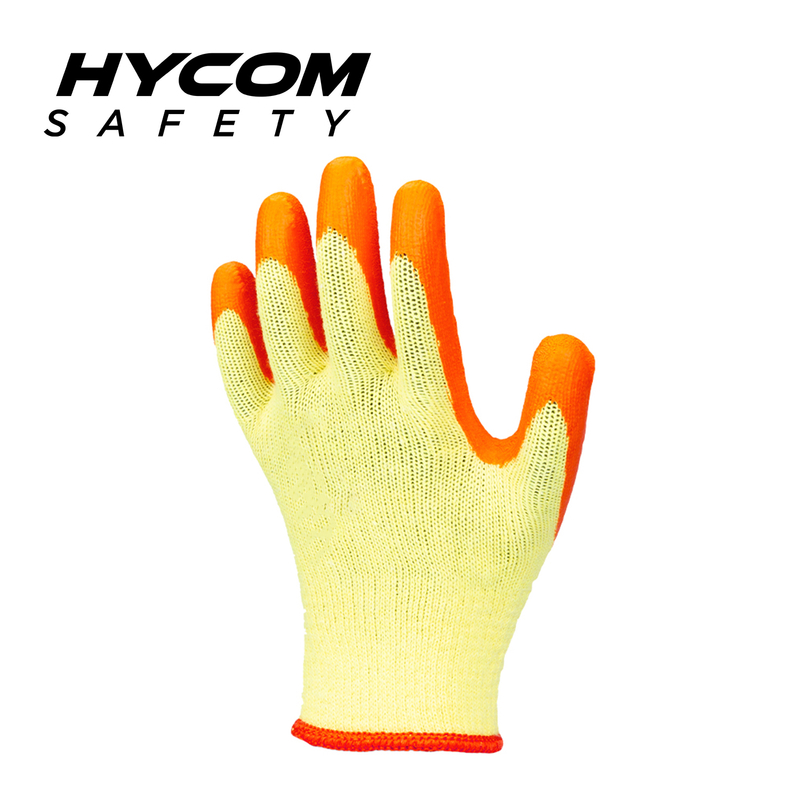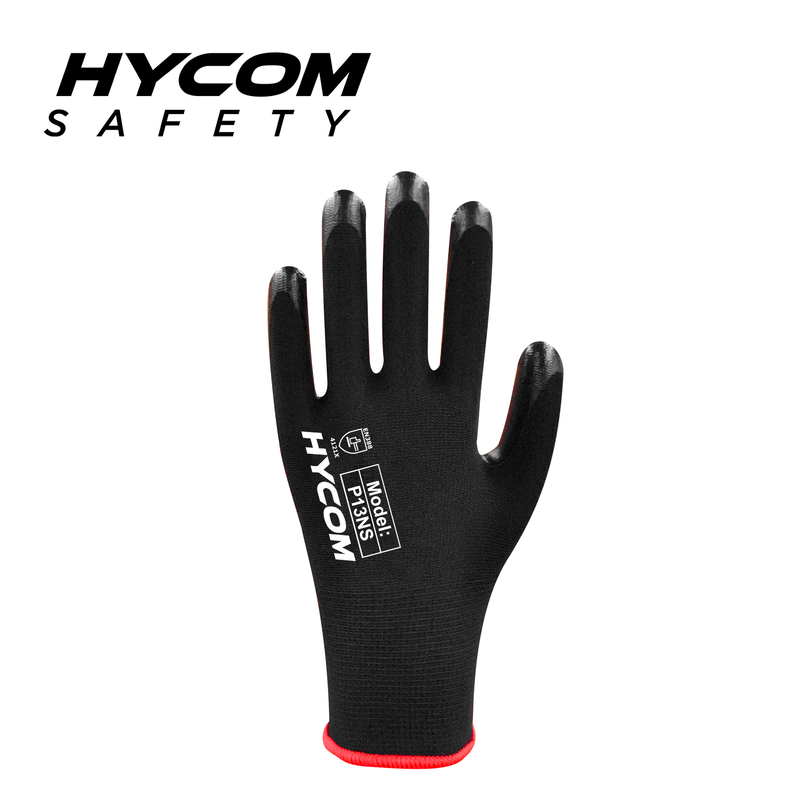Views: 0 Author: Site Editor Publish Time: 2025-10-27 Origin: Site







Anti-Static Cut Resistant Glove Supplier - HYCOM are essential for safety in various industries. They shield hands from sharp objects like needles and metal shards. Understanding their importance and the safety standards governing them is crucial for choosing the right protection. In this post, you'll learn about puncture resistance levels, materials, and innovations ensuring maximum safety."
The ANSI/ISEA 105 standard rates gloves on their puncture resistance using levels 1 through 5. Each level corresponds to the amount of force in newtons a glove can withstand before a sharp object pierces it:
● Level 1: 10–19 newtons — suitable for light tasks like gardening.
● Level 2: 20–59 newtons — good for general construction.
● Level 3: 60–99 newtons — ideal for metal handling.
● Level 4: 100–149 newtons — used in police work or medical waste handling.
● Level 5: 150+ newtons — offers the highest protection for high-risk tasks, such as handling needles or sharp industrial tools.
This rating helps users pick gloves that match the hazards they face. For example, a nurse handling needles needs a Level 4 or 5 glove, while a construction worker might only need Level 2 or 3.
In Europe, the EN388 standard measures glove puncture resistance using a steel stylus pushed through the glove material at a fixed speed. The force needed to puncture the glove is recorded in newtons, similar to ANSI. The test uses a 1mm diameter stylus, which is effective for general puncture hazards but not for very fine needles.
EN388 rates puncture resistance from Level 1 to Level 5, with Level 5 requiring over 150 newtons to puncture the glove. This method gives a reliable indication of how gloves perform against sharp objects like nails, glass shards, or metal fragments.
Puncture resistance and needle resistance are related but different. Regular puncture tests use a thicker stylus, so gloves rated highly for puncture resistance may not protect well against thin needles like hypodermic needles.
To address this, ASTM introduced the F2878-10 test, which uses a 25-gauge needle to simulate needle sticks more accurately. Gloves passing this test provide reliable needle stick protection, which is crucial for healthcare and waste management workers.
For example, a glove might have a Level 5 ANSI puncture rating but fail the needle resistance test. Conversely, a glove designed for needle resistance might have a lower general puncture rating. Knowing the difference helps you pick the right glove for your specific risks.
Always verify if gloves are tested for both puncture and needle resistance when handling sharp medical instruments or needles to ensure maximum protection.

Choosing gloves starts with understanding the job at hand. Different tasks expose hands to different risks, so the right glove depends on the specific hazards you face.
● Medical and Waste Management: These workers often handle needles and sharp objects. They need gloves rated Level 4 or 5 for puncture resistance and sometimes needle resistance too.
● Construction and Manufacturing: Workers face risks from nails, metal shards, and tools. Gloves with Level 2 or 3 puncture resistance usually suffice.
● Law Enforcement and Security: Officers may encounter needles or sharp weapons. Level 4 or 5 gloves with cut and puncture protection provide the best defense.
Matching gloves to your task ensures you get protection without unnecessary bulk or cost.
Materials make a big difference in puncture resistance and comfort.
● Kevlar: A strong synthetic fiber, Kevlar offers excellent puncture and cut resistance. It’s lightweight and flexible, making it popular for high-level protection gloves.
● Nitrile: This synthetic rubber provides good puncture resistance and is often used as a coating on gloves for grip and durability. It’s also resistant to many chemicals.
● Leather: Offers moderate puncture resistance and durability but less cut protection. Often used in construction gloves.
● Advanced Materials: Some gloves use graphene or other innovative fibers to boost protection while keeping gloves light.
Choosing the right material depends on your risk level and comfort needs.
Comfort matters. Gloves that don’t fit well or feel stiff can reduce dexterity and lead to accidents.
● Ensure gloves fit snugly but don’t restrict movement.
● Look for gloves with breathable fabrics to reduce sweating.
● Flexible gloves improve grip and reduce hand fatigue.
● Consider glove length and cuff style for extra protection.
A well-fitted glove encourages consistent use, which is key to safety.
Always test gloves in real work conditions to confirm comfort and protection before making bulk purchases.
Construction and manufacturing workers face constant risks from sharp objects like nails, metal shards, and tools. These hazards can easily cause puncture injuries if gloves lack proper protection. Gloves rated at ANSI Level 2 or 3 often provide sufficient puncture resistance for these industries. For example, a framing contractor handling wood with embedded nails benefits from gloves that resist punctures from these sharp fasteners. Manufacturing workers dealing with metal sheets or machine parts also need gloves that prevent injuries from sharp edges and fragments.
In these industries, puncture wounds are common and costly, leading to lost workdays and medical expenses. Using gloves with appropriate puncture resistance not only protects workers but also reduces downtime and expenses for employers.
Workers in medical and waste management sectors face unique puncture hazards, especially from needles, scalpels, and other sharp medical instruments. These gloves must meet higher puncture resistance standards, typically ANSI Level 4 or 5, to ensure safety against needle sticks and other sharp objects.
Needlestick injuries can transmit bloodborne pathogens like HIV or hepatitis, making protection critical. Gloves designed for these fields often undergo specialized testing, such as the ASTM F2878-10 needle resistance test, which simulates hypodermic needle punctures. For example, hospital staff handling used syringes or waste disposal workers sorting medical refuse rely on these high-level gloves to prevent serious infections.
Law enforcement officers and security personnel encounter hazards from sharp weapons, needles, and other dangerous objects during daily duties. Puncture-resistant gloves rated at Level 4 or 5 provide essential protection. These gloves combine puncture and cut resistance, often made from materials like Kevlar or reinforced synthetics, offering durability and flexibility.
For instance, police officers conducting searches or handling evidence benefit from gloves that protect against hidden needles or sharp objects. Jail and prison workers also require gloves that can withstand potential puncture threats during routine operations.
When selecting gloves for your industry, always match the puncture resistance level to the specific hazards workers face to ensure maximum protection without compromising comfort or dexterity.
Proper cleaning keeps gloves effective longer. Most puncture-resistant gloves benefit from gentle hand washing using mild soap and lukewarm water. Avoid harsh detergents or bleach, which can break down glove fibers and reduce protection. After washing, rinse thoroughly to remove soap residue and air dry in a shaded, well-ventilated area. Never use a dryer or direct heat sources, as high temperatures can damage materials like Kevlar, nitrile, or leather.
For gloves used in medical or hazardous waste settings, follow specific decontamination protocols to avoid contamination risks. Disposable gloves should never be reused and must be discarded after single use.
Regular inspection is key to safety. Before each use, check gloves for holes, tears, or worn spots. Even small punctures can compromise protection. Look carefully at seams and fingertips, where damage often occurs first.
Store gloves in a cool, dry place away from sunlight, chemicals, and extreme temperatures. Heat and UV rays degrade materials, making gloves brittle and less protective. Avoid storing gloves near sharp objects that might accidentally puncture them.
Consider rotating glove stock, using older pairs first to prevent long-term degradation. For reusable gloves, keep them clean and dry between uses to prevent mold or mildew.
● Machine washing or drying: Can damage fibers and coatings, reducing puncture resistance.
● Ignoring small damages: Using gloves with minor cuts or holes risks injury.
● Improper storage: Leaving gloves in direct sunlight or near heat sources shortens lifespan.
● Reusing disposable gloves: Leads to contamination and loss of protection.
● Using gloves beyond recommended lifespan: Materials degrade over time, even if not visibly damaged.
Taking care of gloves is an investment in safety. Proper cleaning, inspection, and storage keep gloves ready to protect hands from puncture hazards.
Always perform a quick glove inspection before use and follow manufacturer cleaning guidelines to maintain maximum puncture resistance and glove lifespan.

The world of puncture-resistant gloves is evolving fast thanks to cutting-edge materials. Kevlar has long been a favorite for its outstanding strength and lightweight feel. It offers excellent puncture and cut resistance, making gloves comfortable yet tough enough for high-risk jobs.
More recently, graphene has entered the scene. This ultra-thin, super-strong material enhances glove durability without adding bulk. Gloves coated or infused with graphene resist punctures better while staying flexible. Imagine gloves that feel like a second skin but stop sharp objects cold. That’s the promise of graphene technology.
Manufacturers often combine Kevlar fibers with graphene layers to create gloves that balance protection, dexterity, and comfort. These materials also resist wear, extending glove lifespan and reducing replacement costs.
Innovation is not just about materials. Smart gloves equipped with sensors are transforming hand protection. These gloves can monitor wear and tear in real-time, alerting users before damage compromises safety.
For example, sensors may detect punctures, cuts, or thinning material and send alerts via Bluetooth to a smartphone or central system. This technology helps workers avoid accidents by replacing gloves before failure.
Smart gloves also track usage patterns, helping safety managers optimize glove replacement schedules and reduce waste. Though still emerging, this tech is gaining traction in industries like healthcare, manufacturing, and hazardous waste management.
Looking ahead, expect more integration of advanced materials and smart tech. Researchers are exploring nanomaterials and bio-based fibers for even lighter, stronger gloves.
Gloves may soon feature multi-layer designs combining puncture, cut, chemical, and heat resistance, all while maintaining comfort. Artificial intelligence could analyze sensor data to predict glove lifespan and recommend replacements automatically.
Customization will improve too. Gloves tailored to individual hand shapes and specific tasks will boost safety and user satisfaction.
In summary, the future of puncture-resistant gloves blends material science and digital innovation to deliver smarter, safer hand protection.
When investing in puncture-resistant gloves, consider advanced materials like Kevlar or graphene and explore smart glove options to enhance safety and glove management.
Understanding puncture resistance levels is crucial for selecting the right gloves. The highest level offers maximum protection against sharp objects, ideal for high-risk tasks. Choosing the right gloves involves considering task-specific needs and material properties. Prioritizing safety ensures protection without compromising comfort and dexterity. At Heat Resistant Sleeve Company, Wholesale Cut Resistant Sleeve - HYCOM, we offer advanced puncture-resistant gloves, combining innovative materials and smart technology to enhance safety and durability. Our products provide exceptional value, ensuring reliable protection in various industries.
A: Puncture-resistant gloves are designed to protect hands from sharp objects like nails or needles by withstanding force without being pierced.
A: Puncture-resistant gloves are rated using standards like ANSI/ISEA 105, which scores gloves from Level 1 to Level 5 based on the force they can resist.
A: Level 5 puncture-resistant gloves offer the highest protection, ideal for handling needles or sharp industrial tools in high-risk tasks.
A: Yes, ASTM F2878-10 tests use a 25-gauge needle for simulating needle sticks, ensuring gloves provide reliable needle stick protection.
A: In medical settings, puncture-resistant gloves prevent needlestick injuries, crucial for avoiding transmission of bloodborne pathogens like HIV.
